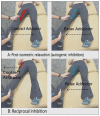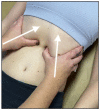Osteopathic Manipulative Medicine: A Brief Review of the Hands-On Treatment Approaches and Their Therapeutic Uses
- PMID: 35622072
- PMCID: PMC9143587
- DOI: 10.3390/medicines9050033
Osteopathic Manipulative Medicine: A Brief Review of the Hands-On Treatment Approaches and Their Therapeutic Uses
Abstract
Osteopathic manipulative medicine (OMM) is an emerging practice in the healthcare field with increasing popularity and evidence-based therapy. Osteopathic manipulative treatments (OMT) include hands-on manipulations of different body structures to increase systemic homeostasis and total patient well-being. Indeed, this new realm of the whole patient-based approach is being taught in osteopathic schools around the country, and the osteopathic principles of a mind-body-spirit-based treatment are being instilled in many new Doctor of Osteopathy (D.O.) students. However, despite their proven therapeutic value, there are still many individuals, both in and outside the medical profession, who are unaware (or misinformed) of the therapeutic uses and potential benefits of OMT. Here, we provide a brief introduction to this osteopathic therapeutic approach, focusing on the hands-on techniques that are regularly implemented in the clinical setting. It is becoming increasingly evident that different OMTs can be implemented to enhance patient recovery, both alone and in conjunction with the targeted therapies used in allopathic regimens. Therefore, it may be beneficial to inform the general medical community and educate the public and those associated with the healthcare field about the benefits of using OMT as a treatment modality. OMT is lower-cost, noninvasive, and highly effective in promoting full-body healing by targeting the nervous, lymphatic, immune, and vascular systems. There is a growing body of literature related to osteopathic research and the possible molecular pathways involved in the healing process, and this burgeoning field of medicine is expected to increase in value in the healthcare field. This brief review article explains the frequently utilized OMT modalities and their recognized therapeutic benefits, which underscore the need to understand the possible molecular mechanisms and circulating biomarkers linked to the systemic benefits of osteopathic medicine.
Keywords: HVLA (High-velocity low amplitude); balanced ligamentous tension; cranial osteopathy; diaphragm; lymphatic pump; muscle energy; myofascial release; osteopathy.
Conflict of interest statement
The authors declare no competing financial interest.
Figures







References
-
- Chila A.G. Foundations of Osteopathic Medicine. Lippincott Williams & Wilkins; Philadelphia, PA, USA: 2011.
-
- American Osteopathic Organization OMP 2019 Report. Osteopathic.Org. [(accessed on 20 July 2021)]. Available online: https://osteopathic.org/wp-content/uploads/OMP2019-Report_Web_FINAL.pdf.
-
- Stamat H.M., Injety R. Osteopathic Medicine and Community Health Fairs: Increasing Public Awareness While Improving Public Health. J. Am. Osteopath. Assoc. 2008;108:397–403. - PubMed
-
- Johnson S.M., Kurtz M. Osteopathic Manipulative Treatment Techniques Preferred by Contemporary Osteopathic Physicians. J. Am. Osteopath. Assoc. 2003;103:219–223. - PubMed
Publication types
LinkOut - more resources
Full Text Sources
Medical

